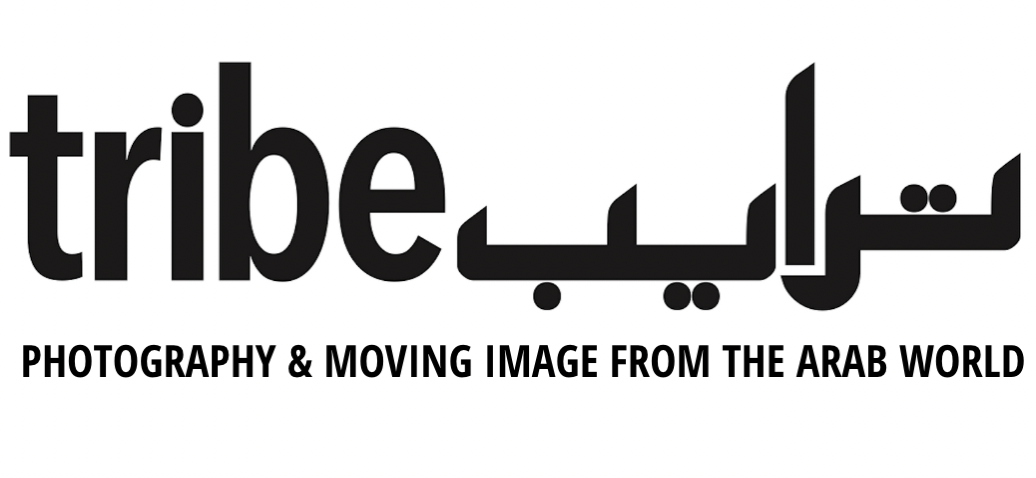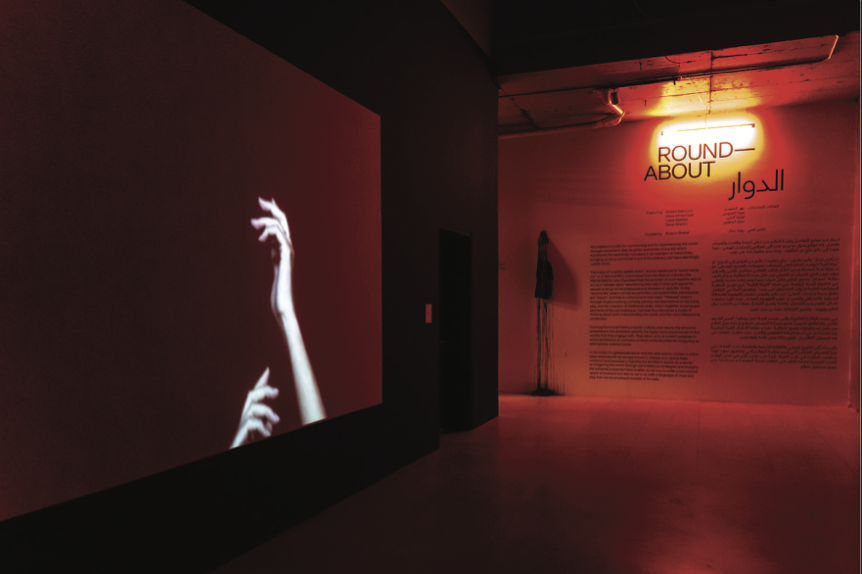Roundabout: Ahaad Alamoudi, Moza Almazrouei, Lulua Alyahya, and Sarah BrahimATHR Gallery, Jeddah
By Rotana Shaker
Roundabout is a site for communing and experiencing the world through movement, play, laughter, and action; a site that transforms the seemingly mundane, in an inversion of hierarchies, bringing us into a world that is out of the ordinary, perhaps upside down.
The trope of “a world upside down”—and its variations (a “world inside out” or a “second life”)—has been used to describe the rich framework of Medieval carnivals and festivals. This terminology is borrowed from cultural critic Mikhail Bakhtin and expanded upon by historian Edward Muir, who theorized that the purpose of such festivity was to act as a “release valve,” sanctioning intervals of time and space for people to let go of the pressures and stresses of daily life. In this “second life,” where normal social orders are suspended, participants are “reborn” and free to commune in new ways. “Release” occurs through rituals involving comedy, parody, indulgence, play, and the inversion of traditional order, which together encompass elements of the carnivalesque. Carnival thus becomes a mode of thinking about and understanding the world, and the carnivalesque its vocabulary.
In the GCC, such moments of communal laughter and play are exemplified through traditions of children collecting candy and dressing up for Gergee’an or Hag Elaila, and in the act of gathering to watch satirical and seasonal comedies like the Saudi television series Tash ma Tash, for example. Such festivities serve to mark the transitions between different seasons or the start of religious holidays. As such, carnivalesque rituals also serve another function: they aid us in transitioning between different modes of being.
Exhibiting in the midst of a global pandemic and the attempts to contain it, restricting life as we knew it, release and rebirth felt imminent and necessary. Figuring the exhibition space as a site for re-imagining the world through carnivalesque strategies and imagery, the presented artworks enabled us not only to enter a sanctioned space of inversion but also to carry on with a language of ritual and play that could be employed outside of its walls. The artists tackled the world around them with a ferocious wit, critical eye, and regenerative power.
Ahaad Alamoudi’s video works humorously to investigate the order of our world. The Three (2021) is a three-channel video viewed within a playground roundabout/carousel, incorporating social commentary, parody, and play. Here, three voices express differing perspectives on the rapid social and infrastructural changes they observe; one championing, another resisting, and the third ambivalent.
In carnival, the inversion of traditional social order often takes place through masquerade and plays in which citizens take on new identities and parody the mannerisms of other social classes to upend the distribution of power and reveal deep truths about its order. The figures in Lulua Alyahya’s paintings are depictions of everyday life and figures with amalgamations of features borrowed from different people, both real and fictional, perhaps alluding to familiar social “types,” whichare situated in eerie, unspecified locations and yet are adeptly specific in their facial expressions and interactions. This warping of otherwise mundane scenes unmasks the subjects’ true faces—often menacing or confrontational, revealing the world through the lens of a young woman’s experience.
In Rabelais and His World (1986), a historical analysis of humor in the Middle Ages, Bakhtin asserts, “Carnival was the true feast of time, the feast of becoming, change, and renewal. It was hostile to all that was immortalized and completed.” Moza Almazrouei’s work from the Annelid Archive (2021) aims to inspect the gaps of knowledge between a historical event and a document that isn’t registered through aninstitutional archive. Her photographs capture scenes from the archives of the Juma Almajid Center for Culture and Heritage in Dubai, where hands are shown touching, laying out, and treating old manuscripts for preservation. Juxtaposed with these images is her delicate rambutan peel sculpture, which she preserves by applying her own archival drying processes. Both the worn pages in the photographs and the delicate natural material allude to the inevitability of eventual wearing and decay; exposing the fragility of our established sense of order.
In Sarah Brahim’s video Bodyland/Back to Dust (2020), disembodied hands are expressive appendages that are sites of memory. Her choreographed performance is an embodied archive of collected gestures, transmitting
culturally specific meaning. Her art explores the body and our relationship to land through choreography, textile, and sound. Using natural elements and grounding her work in the movement of the body, Brahim takes an interest in a return to nature. Bakhtin’s conception of grotesque realism conceives of degradation as grounding, a return to the earth and its regenerative power. If Alamoudi’s voices in The Three participate in the conversation about change, development, and time by riding the roundabout, diverging, and converging in an endless mechanized loop, then Brahim proposes a path to break away. Snaking visitors’ bodies through her naturally dyed and frayed textiles in The Dance of the Mountain (2021), the former are brought back to the body and land, liberated from the endless loop of modernization and drawn into another loop of death and rebirth.
Including painting, sculpture, sound, video, and installations, Roundabout brings forth questions about our experience of time, our re-imagining of the future, and coming to terms with the realities of our present. Drawing from local history, popular culture, and nature, the artists specify the topsy- turvy experiences of the worlds with which they engage. In the context of living through a pandemic that seemed to have turned lives upside down, perhaps they allow us to re-orient ourselves to some semblance of normalcy, or lend us the faculties to imagine an alternatively ordered future.




